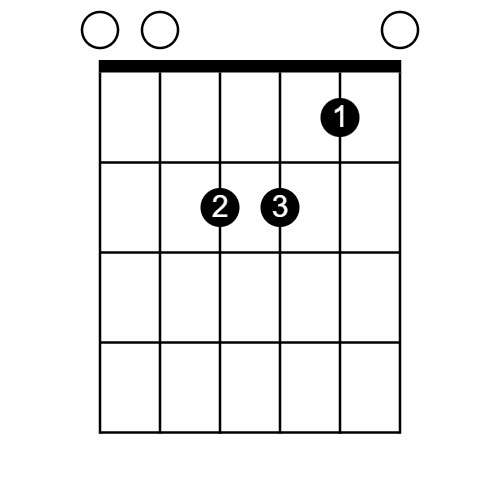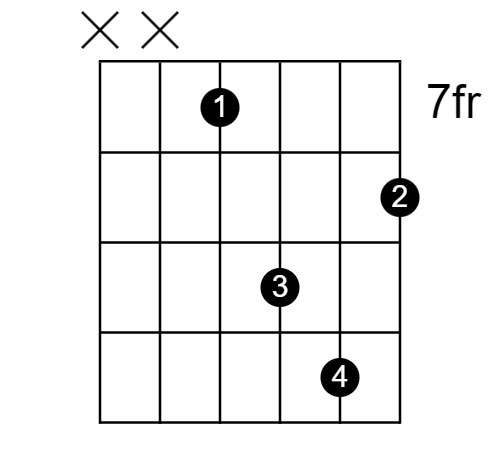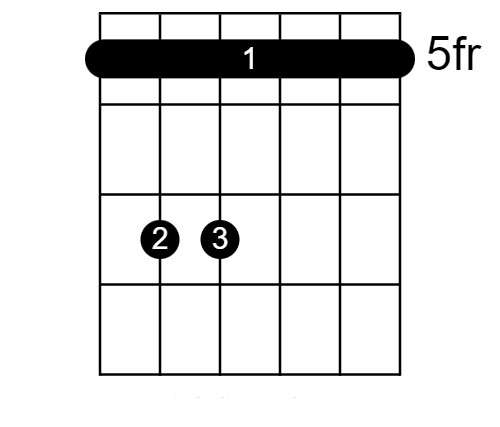The A minor (A m guitar chord) is an essential chord for beginner guitar player and those seeking to expand their chord repertoire. It is widely used in various music genres, including folk, rock, pop, and blues. Mastering the A minor chord is crucial for becoming a versatile guitarist as it’s so commonly used.
Forming the Am chord is relatively easy, requiring only three fingers on the guitar fretboard. We’ll show you how to pull it off, plus, show you how to play it in a couple more ways. This chord produces a somber & melancholic sound, often used to convey emotions in songs. With this new musical tool, you’ll be able to inject contrast, tone & moodiness into your music.

Am Chord Basics
The A minor (Am) guitar chord is composed of specific notes that create its distinct sound. It consists of the notes A, C, and E, which are played simultaneously.
The “m” in A minor stands for “minor,” indicating that the chord has a minor tonality. If the “m” was capitalized, then it would mean that the chord is “Major” instead of minor. More on that later!
In terms of intervals, the Am chord is constructed with three notes: a root note (A), a minor third interval (C), and a perfect fifth interval (E). This is also known as playing a minor triad.
Another important aspect of the A minor chord is its relationship to the relative minor chord, which is C major. This means that if you play the C major chord, starting from the note C, it shares the same notes as the A minor chord.
A major benefit of relative guitar chords is that they make it convenient to transition between major & minor keys or to create harmonic variations within a piece of music.
By incorporating the relative chord, you can introduce a contrasting mood or evoke different emotions within your compositions.
How To Play The A Minor Chord
Below are step by step instruction on how to play 3 versions of the Am chord.
Cant decipher the chord diagram below? Check out our article on how to read a chord diagram
Version 1 Open Position

Place your first finger (index finger) on the first fret of the B string
Next, place your second finger (middle finger) on the second fret of the D string (fourth string)
Then, your third finger (ring finger) on the second fret of the G string
Finally, strum from the A string downward, excluding the low E string (thickest string)
Version 2

Place your first finger (index) on the 7th fret of the D string (fourth string)
Next, place your second finger (middle) on the 8th fret of the high E string
Then, place your third finger (ring) on the 9th fret of the G string
Now, place your fourth finger ( pinky) on the 10th fret of the B string & strum all the strings you just pressed down but omit the lower 2 (Low E & A)
Version 3 Barre Chord

This one is a bit more tricky because you have to bar all of the strings with a single finger.
Start by placing your first finger (index) across all the strings on the 5th fret.
Next, add your middle finger to the 7th fret on the A string
Finally, add your ring finger to the 7th fret on the D string & strum all of the strings.
Related: What Are Barre Chords & How To Play Them
Major vs Minor Chords
Major Chords
Major chords have a bright and uplifting quality, often associated with feelings of happiness, positivity, and resolve. They convey a sense of stability and are commonly used in joyful or triumphant musical compositions. Major chords are typically perceived as more “cheerful” or “optimistic” in their sound and evoke a positive mood.
Minor Chords
Minor chords have a more somber and melancholic sound, often associated with feelings of sadness, introspection, or longing. They create a sense of tension and can convey a range of emotions, including introspection, nostalgia, or even despair. Minor chords are often used to evoke a more “serious” or “introspective” mood in music & are derived from the minor scale.
The key difference in tonality between minor and major chords lies in the third interval. Major chords have a major third interval between the root and the third note, while minor chords have a minor third interval. This difference in interval creates the contrasting emotional qualities and distinct sound between minor and major chords.
In summary, major chords sound bright, happy, and stable, while minor chords sound somber, introspective, and convey a sense of tension.
Related: The easiest minor chords on the guitar to play
Popular Songs That Use The A m Guitar Chord
Babe, I’m Gonna Leave You
Breaking The Law
Californication
Creep
While My Guitar Gently Weeps
Wonderwall
Frequently Asked Questions
What is the hardest guitar chord ever?
The hardest chord is subjective, but in general, many new guitarists have difficulty with barre chords.
For example, the F barre chord requires barring the first fret with the index finger and forming a complex finger placement involving the remaining fingers.
The stretch and finger strength required to hold down all the strings necessary can be difficult for many players, especially if they have not built up the muscle memory.
What is the saddest guitar chord?
In general, all minor chords produce a sad or melancholic guitar tone. If you want to dive deeper into playing a sorrow mood, check out minor chords with added extensions like the minor seventh (m7)
Here’s a couple to get you started: Dm7 – Bm7 – Am7
What chord can I substitute for Am?
The C major (C) chord can be used as a substitute for the A minor (Am) chord. As the relative major chord of A minor, they share the same notes.
Substituting C major for Am creates a different tonal color while maintaining harmonic connection.
This substitution works well in specific musical contexts, offering a contrasting or brighter sound.
Experimenting with this substitution in chord progressions can alter the mood and feel of the music.
However, the appropriateness of the substitution depends on the specific piece and desired effect. Trust your ear and musical intuition when exploring chord substitutions.
